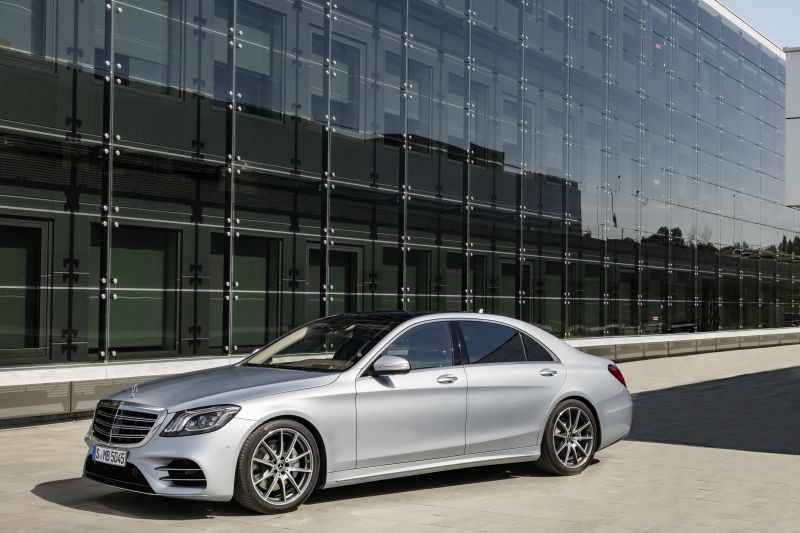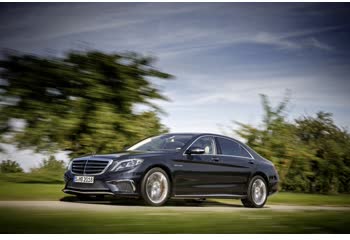Everything you need to know about specifications and performance - Mercedes-Benz S-class 2018 - S 560e V6 (476 Hp) Plug-in Hybrid 9G-TRONIC

Overview:
What is the engine capacity of a Mercedes-Benz S-class 2018?
The engine capacity of the Mercedes-Benz S-class 2018 is 2996.
Mercedes-Benz S-class 2018 How many horsepower?
The engine power of the Mercedes-Benz S-class 2018 is 367 Hp @ 5500-6000 rpm..
What is the Mercedes-Benz S-class 2018 engine?
Mercedes-Benz S-class 2018 engine is M 276.824. (Click to see other cars using the same engine)
How powerful is the electrical system in the Mercedes-Benz S-class 2018?
The power of the electrical system in the Mercedes-Benz S-class 2018 is 476 Hp hp.
How much gasoline does a Mercedes-Benz S-class 2018 consume?
The Mercedes-Benz S-class 2018 consumes 2.5-2.6 liters of gasoline per 100 km
General:
Brand: Mercedes-Benz
Model: S-class
Generation: S-class Long (V222, facelift 2017)
Modification (Engine): S 560e V6 (476 Hp) Plug-in Hybrid 9G-TRONIC
Start of production: October, 2018
End of production: September, 2020
Powertrain Architecture:Plug-In Hybrid Electric Vehicles (PHEVs)
Body type:Sedan
Seats: 4
Doors: 4
Engine:
Engine systems: Start & Stop System
Power: 367 hp @ 5500-6000 rpm.
Power per litre: 122.5 hp/l
Torque: 500 nm @ 1800-4500 rpm.
Engine Model/Code: m 276.824
Engine displacement: 2996
Number of cylinders: 6
Engine configuration: V-engine
Number of valves per cylinder: 4
Fuel injection system: Direct injection
Engine aspiration: Twin-Turbo, Intercooler
Valvetrain: DOHC
Engine oil capacity: 6.5 l
Engine layout: Front, Longitudinal
Cylinder Bore: 88 mm
Piston Stroke: 82.1 mm
Compression ratio: 10.7:1
Performance:
Fuel Type: Petrol / electricity
Fuel consumption (economy) - combined (NEDC): 2.5-2.6 l/100 km
Fuel consumption (economy) - combined: 2.5-2.6 l/100 km
Emission standard: Euro 6d-TEMP-EVAP-ISC
Acceleration 0 - 100 km/h: 5 sec
Acceleration 0 - 62 mph: 5 sec
Maximum speed: 250 km/h, Electronically limited
Weight-to-power ratio: 4.6 kg/Hp, 218.3 Hp/tonne
Weight-to-torque ratio: 3.1 kg/Nm, 321.1 Nm/tonne
Max speed (electric): 130 km/h
Acceleration 0 - 60 mph: 4.8 sec
Electric system:
Gross battery capacity: 13.5 kWh
Battery technology: Lithium-ion (Li-Ion)
Battery location: Inside the trunk
System power: 476 hp
System torque: 700 nm
All-electric range: 50 km
Electric motor power: 122 hp
Electric motor Torque: 440 nm @ 0-2000 rpm.
Average Energy consumption: 20-20.2 kWh/100 km
Electric motor location: Between the combustion Engine and the transmission
Average Energy consumption (NEDC): 20-20.2 kWh/100 km
All-electric range (NEDC): 50 km
Space:
Kerb Weight (kg): 2180
Max. weight (kg): 2825
Max load (kg): 645
Trunk (boot) space - minimum: 410 l
Fuel tank capacity: 63 l
dimensions:
Ramp-over (brakeover) angle: 11°
Length: 5255 mm
Width: 1899 mm
Height: 1494 mm
wheelbase: 3165 mm
Width including mirrors: 2130 mm
Front track: 1624 mm
Rear (Back) track: 1637 mm
Front overhang: 897 mm
Rear overhang: 1193 mm
Ride height (ground clearance): 128 mm
Minimum turning circle (turning diameter): 12.3 m
Approach angle: 14.8°
Departure angle: 15.8°
Powertrain, Suspension and Brakes:
Drivetrain Architecture: The Internal combustion Engine (ICE) and electric motor drive the rear wheels of the car with the ability to work in full electric or mixed mode.
Drive wheel: Rear wheel drive
Number of gears and type of gearbox: 9 gears, automatic transmission G-TRONIC
Front brakes: Ventilated discs
Rear brakes: Ventilated discs
Assisting systems: ABS (Anti-lock braking system)
Steering type: Steering rack and pinion
Power steering: Electric Steering
Tires size: Front wheel tires: 245/50 R18; 245/45 R19; 245/40 R20
Wheel rims size: Front wheel rims: 8J x 18; 8.5J x 19; 8.5J x 20
Front suspension: Double wishbone, Transverse stabilizer, Air suspension
Rear suspension: Independent multi-link suspension, Air suspension, Transverse stabilizer
See also

Other generation.
Its production began in 2013 until 2016
Write a comment